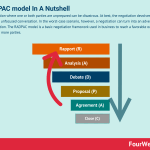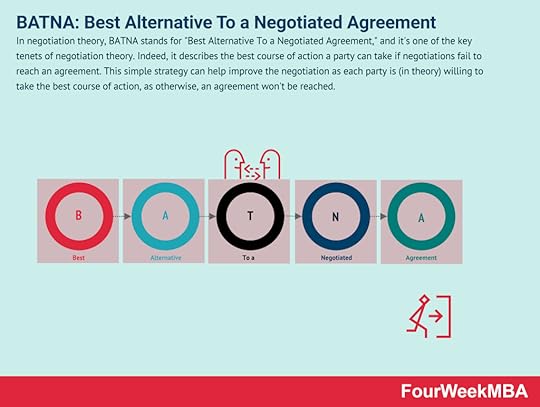What Is The RADPAC Model? RADPAC Model In A Nutshell

A negotiation where one or both parties are unprepared can be disastrous. At best, the negotiation devolves into a loose and unfocused conversation. In the worst-case scenario, however, a negotiation can turn into an adversarial confrontation. The RADPAC model is a basic negotiation framework used in business to reach a favorable outcome for two or more parties.
Understanding the RADPAC modelThe RADPAC model is a simple framework giving structure to a formal negotiation process and is widely used in business and corporate contexts. Most importantly, the model increases the likelihood a favorable and meaningful outcome eventuates for both sides.
In the next section, we’ll discuss the various components of the approach.
The six components of the RADPAC modelThe RADPAC model is made up of six components which give the model its name:
Rapport (R) – before starting the negotiation itself, both parties must first work to develop rapport with friendly, social conversation. This creates a comfortable and collaborative environment and if done correctly, sets a positive tone for the rest of the process.Analysis (A) – to begin the formal negotiation, each party must understand the perspective of the other by establishing facts and empathizing with feelings where possible. The point of this step is to develop an understanding of the other party and establish a basis for negotiation. There is no need for both parties to be in agreement. Otherwise, there would be no need for negotiation in the first place.Debate (D) – when many people think of debating, they assume it to be a zero-sum game where one party wins at the expense of the other. However, debating in a negotiation means searching for mutually agreeable solutions by maintaining a collaborative environment.Proposal (P) – in the fourth step, one or both parties suggests viable and mutually agreeable solutions. These solutions may partially or completely satisfy the needs of each party, depending on how well the negotiation has been handled until this point. In any case, a compromise acceptable to all should be the ultimate objective.Agreement (A) – the agreement stage begins with both parties restating what they have agreed to in the proposal stage. The logistics of the proposal – such as the allocation of time, money, and other resources – should also be discussed and defined. Lastly, the agreement should be recorded and read back to everyone in the room to ensure it is correct.Close (C) – a successful close should leave the door open for future negotiation between the two parties. Each party should thank the other for playing their role and then make a firm commitment to undertake any follow-up actions. Key takeaways:The RADPAC model is a basic negotiation framework used in business to reach a favorable outcome for two or more parties.The RADPAC model gives structure and clarity to a formal negotiation process. This avoids a scenario where the negotiation deteriorates into an adversarial confrontation or becomes loose and unfocused.The RADPAC model is based on six key steps: rapport, analysis, debate, proposal, agreement, and close. Both parties should take their time moving through the steps to foster a collaborative environment.Connected Negotiation Frameworks The Fishbone Diagram is a diagram-based technique used in brainstorming to identify potential causes for a problem, thus it is a visual representation of cause and effect. The problem or effect serves as the head of the fish. Possible causes of the problem are listed on the individual “bones” of the fish. This encourages problem-solving teams to consider a wide range of alternatives.
The Fishbone Diagram is a diagram-based technique used in brainstorming to identify potential causes for a problem, thus it is a visual representation of cause and effect. The problem or effect serves as the head of the fish. Possible causes of the problem are listed on the individual “bones” of the fish. This encourages problem-solving teams to consider a wide range of alternatives. In negotiation theory, BATNA stands for “Best Alternative To a Negotiated Agreement,” and it’s one of the key tenets of negotiation theory. Indeed, it describes the best course of action a party can take if negotiations fail to reach an agreement. This simple strategy can help improve the negotiation as each party is (in theory) willing to take the best course of action, as otherwise, an agreement won’t be reached.
In negotiation theory, BATNA stands for “Best Alternative To a Negotiated Agreement,” and it’s one of the key tenets of negotiation theory. Indeed, it describes the best course of action a party can take if negotiations fail to reach an agreement. This simple strategy can help improve the negotiation as each party is (in theory) willing to take the best course of action, as otherwise, an agreement won’t be reached. In negotiation, WATNA stands for “worst alternative to a negotiated agreement,” representing one of several alternative options if a resolution cannot be reached. This is a useful technique to help understand what might be a negotiation outcome, that even if negative is still better than a WATNA, making the deal still feasible.
In negotiation, WATNA stands for “worst alternative to a negotiated agreement,” representing one of several alternative options if a resolution cannot be reached. This is a useful technique to help understand what might be a negotiation outcome, that even if negative is still better than a WATNA, making the deal still feasible. The ZOPA (zone of possible agreement) describes an area in which two negotiation parties may find common ground. Indeed, ZOPA is critical to explore the deals where the parties get a mutually beneficial outcome to prevent the risk of a win-lose, or lose-win scenario. And therefore get to the point of a win-win negotiation outcome.
The ZOPA (zone of possible agreement) describes an area in which two negotiation parties may find common ground. Indeed, ZOPA is critical to explore the deals where the parties get a mutually beneficial outcome to prevent the risk of a win-lose, or lose-win scenario. And therefore get to the point of a win-win negotiation outcome. In a logrolling negotiation, one party offers a concession on one issue to gain ground on another issue. In logrolling, there is no desire by either party to advertise the extent of their power, rights, or entitlements. This makes it a particularly effective strategy in complex negotiations where partial or complete impasses exist.
In a logrolling negotiation, one party offers a concession on one issue to gain ground on another issue. In logrolling, there is no desire by either party to advertise the extent of their power, rights, or entitlements. This makes it a particularly effective strategy in complex negotiations where partial or complete impasses exist. The Theory of Constraints was developed in 1984 by business management guru Eliyahu Goldratt in his book The Goal. The Theory of Constraints argues that every system has at least one constraint that hinders high-level performance or profit generation. Fundamentally, the theory advocates identifying constraints and then eliminating them or at the very least, reducing their impact.
The Theory of Constraints was developed in 1984 by business management guru Eliyahu Goldratt in his book The Goal. The Theory of Constraints argues that every system has at least one constraint that hinders high-level performance or profit generation. Fundamentally, the theory advocates identifying constraints and then eliminating them or at the very least, reducing their impact.Read Next: Negotiation, Logrolling, BATNA, WATNA, ZOPA.
Main Free Guides:
Business ModelsBusiness StrategyBusiness DevelopmentDigital Business ModelsDistribution ChannelsMarketing StrategyPlatform Business ModelsTech Business ModelThe post What Is The RADPAC Model? RADPAC Model In A Nutshell appeared first on FourWeekMBA.



